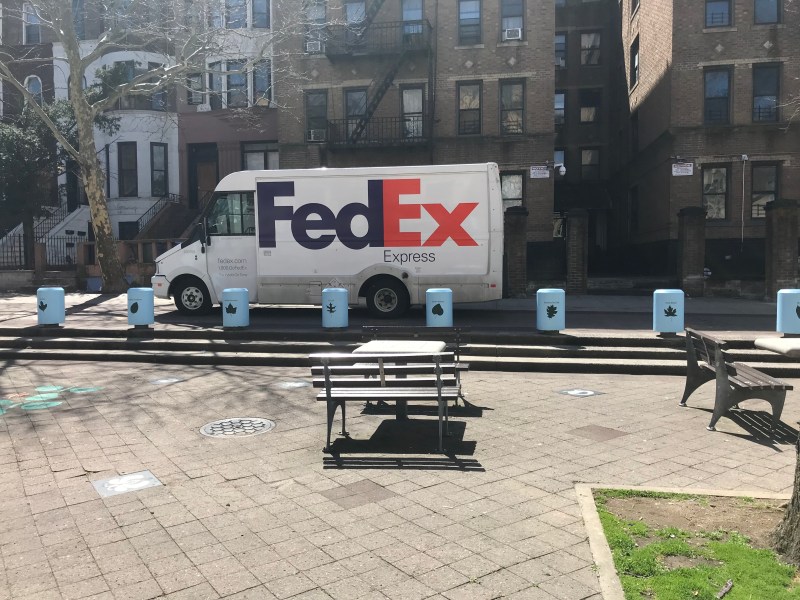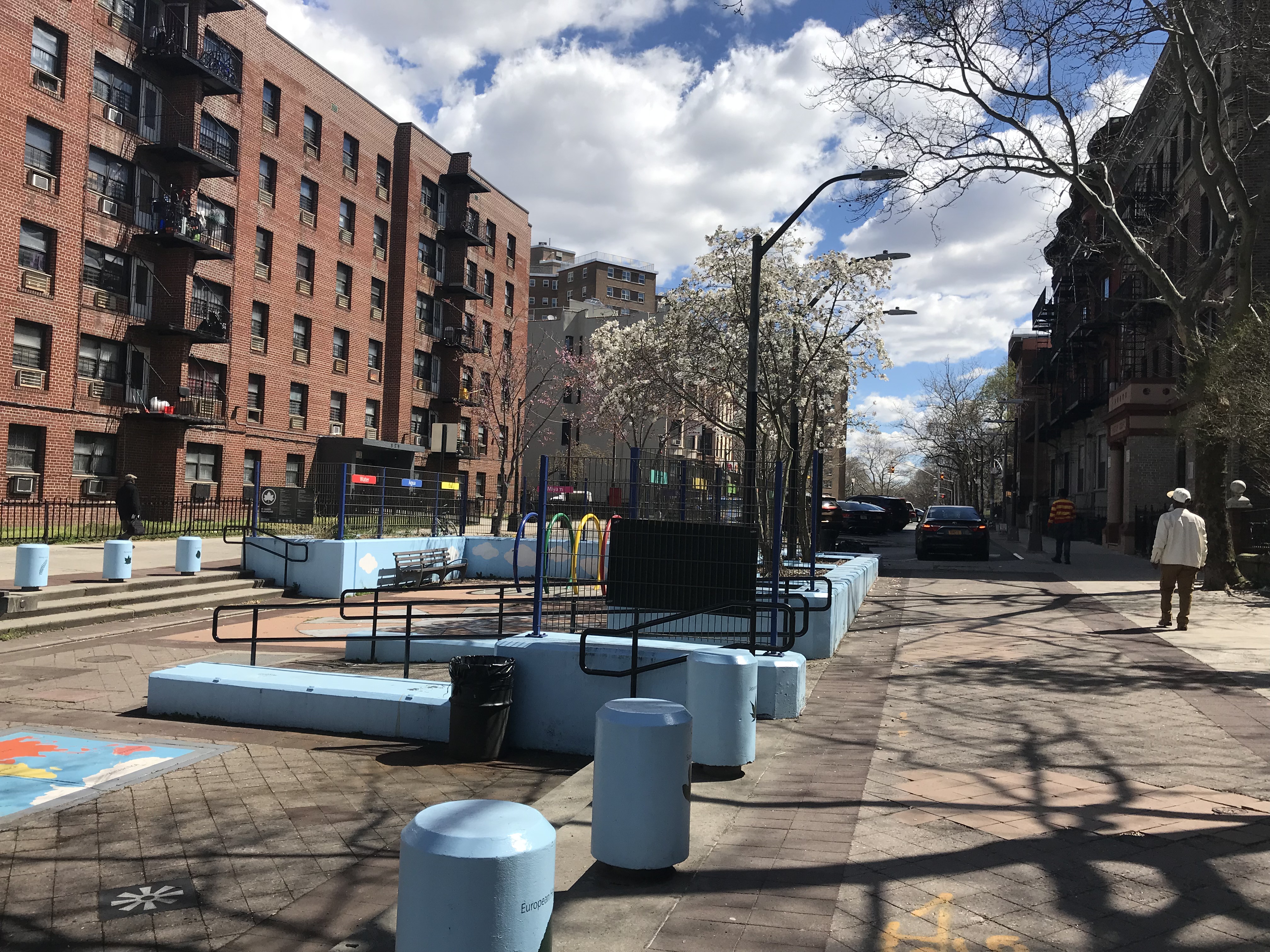Scott Stringer Channels Robert F. Kennedy in Vision for Mid-Block Playgrounds

Comptroller Scott Stringer is going back to the future to turn through streets that slice through quiet neighborhoods into cul-de-sacs with playgrounds in the middle — an idea championed by then-Senator Robert F. Kennedy, but allowed to languish due to city inaction.
Stringer’s initiative, called “Pavement to Playgrounds,” would sever hundreds of roadways to create two mini parking lots on either end and a middle-of-the-block park or plaza.
https://twitter.com/NYCComptroller/status/1122171795380084736
Stringer says the “model is proven to work” — but Streetsblog found that it doesn’t always. A 1970s-era version of Stringer’s plan exists on St. Marks Avenue between Kingston and Albany avenues in Crown Heights, which was once a regular city through street that was reborn as a mid-block playground protected by small parking lots on either side — a vision championed by Kennedy. The area in question resembles almost identically the diagram that Stringer’s office tweeted.
The problem? Motorists routinely put kids’ lives in danger by driving on the sidewalk.
Yes, there are small “Do Not Enter” signs that tell motorists not to drive down on the sidewalk, but there are no physical barriers such as bollards. As a result, scofflaw motorists and delivery trucks — plus police officers from the neighborhood’s 77th Precinct — regularly drive down the sidewalk instead of choosing another roadway. (Yes, Mr. Mayor, there are cars on sidewalks.)
“A lot of time there’s dudes driving on the sidewalk,” said Dave, who declined to give his last name. “It happens a lot.”
The unique street design, at the time called a “superblock,” was the brainchild of the Bedford-Stuyvesant Restoration Corporation after then-Senator Kennedy toured the neighborhood in the late 1960s. The group developed the middle-of-the-block park “as a way to break the monotonous street grid and provide opportunities for recreation, respite, and an improved pedestrian experience,” according to the Historic Districts Council. Kennedy created another superblock on Prospect Place between the same avenues in order to generate open space in the neighborhood, which was suffering at the time from poverty and despair. Some thought there would someday be hundreds of them, but very few were ever built.
“The superblock there was intended to enliven the street and create desirable public space,” said Jesse Denno, from the Council. “This was a holistic urban restoration plan.”

Archives from the Bedford-Stuyvesant Restoration Corporation suggest that the St. Marks Avenue park was supposed to be replicated on a larger scale throughout the city as a leading example of creating public space by eliminating car traffic, but that never came to fruition because of financial instability.
“While the economic feasibility of the completing the Superblock Program on the scale originally envisioned could not be sustained, several key building blocks for future Restoration housing development emerged from his effort,” according to documents from the Corporation.

The park was also a legacy of the renowned and Pritzker prize-winning architect, I.M. Pei — who died at the age of 102 on May 16. The park, which features kids’ play spaces, tables and benches, and a fountain, is bounded by 27 parking spots on one side and 22 on the other. About 15 years after it was created, the Department of Transportation officially closed the street to all traffic except for emergency vehicles.
Very sad about the passing of I.M. Pei. A giant in his field & a life well lived.
One brilliant, but oft-overlooked, project was this playground in Brooklyn.
As tribute to Pei’s extraordinary life & career, let’s build 100 more like this across NYC! #PavementToPlaygrounds pic.twitter.com/pQrypoDkXr
— Adam Batlan (@LeoniaBatlan) May 18, 2019
Still, today, no bollards or other anti-car devices prevent motorists from driving down the sidewalk, just feet from where kids are playing — and the street is no safer than any other block in the city because of that, said the St. Marks resident.
“I think it’s worse,” he said.
But locals likely learned the dangerous shortcut from cops, who regularly speed right past the park, said another St. Marks resident.
“I definitely think the cops initiate it. You don’t naturally think you can drive on the sidewalk until you see someone of the law or someone of a higher authority do it,” said Leon Smith. “They set the trend.”
And there have been some close calls with cop cars knocking over little kids, said a mother who lives on the block.
“Police almost ran over one of my friend’s kids,” said Jennifer, who declined to give her last name.
In the span of about 30 minutes, this reporter spotted three cars driving on the sidewalk — including one FedEx truck making deliveries.
One cyclist dismissed Stringer’s plan as something that appears to be a good design for residents, but is really just a redesign for drivers.
“A version of this in Crown Heights always struck me as a parking lot with a parklet thrown in,” tweeted Geof with One F. “It’s a complete streets fail to placate some screaming drivers.”
A version of this in Crown Heights always struck me as a parking lot with a parklet thrown in, and in this mockup it looks really hard to incorporate bike infrastructure without sacrificing space for pedestrians. It's a complete streets fail to placate some screaming drivers. https://t.co/bTf42xDK6D
— GB "The Ghost of S.7000A" Metz (@notthegiraffe) April 28, 2019
Police did not respond to a request for comment about the scofflaw cops, and the Department of Transportation said it has no plans to place bollards on the block, but did not say why.


